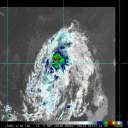Show Selection:
|
#718007 (Received by flhurricane at: 11:02 AM 16.Sep.2014)
TCDAT1
HURRICANE EDOUARD DISCUSSION NUMBER 21
NWS NATIONAL HURRICANE CENTER MIAMI FL AL062014
1100 AM AST TUE SEP 16 2014
Visible satellite images show that Edouard has an impressive
satellite presentation, displaying a well-defined eye within the
central dense overcast. Edouard is upgraded to a major
hurricane based on a subjective Dvorak intensity estimate of 102 kt
from TAFB, an ADT estimate of 107 kt, and a recent SFMR surface
wind of 97 kt in the southwest eyewall. Edouard is the first major
hurricane of the 2014 Atlantic hurricane season, and the
first category 3 or greater hurricane in the basin since Sandy on
October 25, 2012.
Edouard is expected to reach its peak intensity within the next
12-18 hours while it remains in light shear conditions and over warm
waters. A combination of decreasing SSTs and increasing shear
should cause the hurricane to start a steady weakening by late
tomorrow. The intensity guidance is in good agreement, and the
latest NHC forecast is close to the previous NHC prediction and the
intensity consensus. Edouard is expected to become post-tropical by
day 4, but this transition could even occur around day 3 due to
rather cool waters in the cyclone's path.
The initial motion is gradually shifting to the right, now 345/11.
Edouard remains located to the west of the subtropical high and will
turn northward and northeastward into the mid-latitude westerlies
during the next 24-36 hours. An eastward acceleration is expected
by 48 hours, and the cyclone is forecast to turn southeastward and
slow down on days 4 and 5 when it approaches the west side of a
deep-layer low between Portugal and the Azores. The interaction of
the low and the tropical cyclone is causing the model guidance to
become more divergent at long range, with the GFS and the GFDL
models taking the cyclone well north of the Azores. However,
the GFS ensemble is much farther southwest than the deterministic
GFS, and is much more consistent with the previous forecast and the
bulk of the guidance. Thus, I have elected to leave the NHC
prediction virtually unchanged from the previous one, even though
the model consensus is a fair distance to the northeast of the new
official track at long range.
FORECAST POSITIONS AND MAX WINDS
INIT 16/1500Z 31.1N 57.8W 100 KT 115 MPH
12H 17/0000Z 33.0N 57.1W 100 KT 115 MPH
24H 17/1200Z 35.7N 54.6W 95 KT 110 MPH
36H 18/0000Z 38.4N 50.6W 85 KT 100 MPH
48H 18/1200Z 40.3N 45.7W 75 KT 85 MPH
72H 19/1200Z 41.0N 38.5W 55 KT 65 MPH
96H 20/1200Z 40.0N 35.0W 40 KT 45 MPH...POST-TROPICAL
120H 21/1200Z 38.0N 32.0W 30 KT 35 MPH...POST-TROPICAL
$$
Forecaster Blake |



